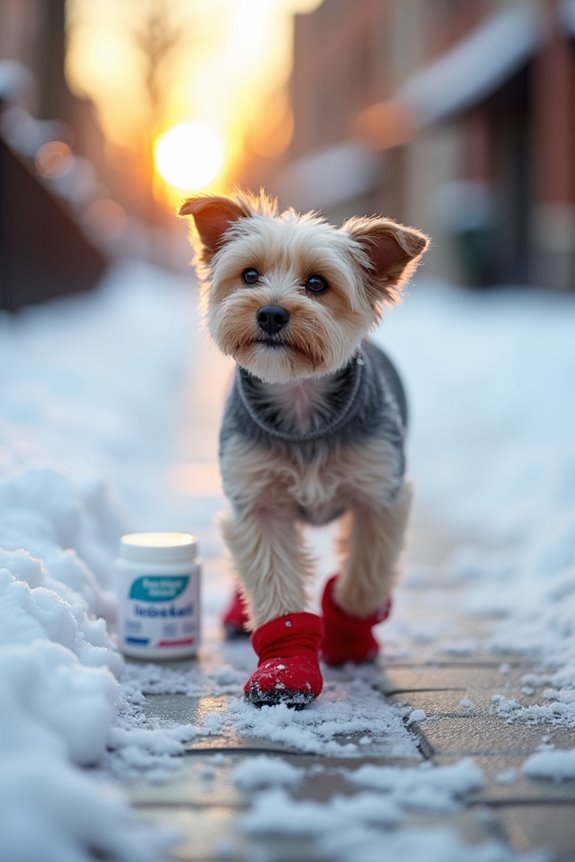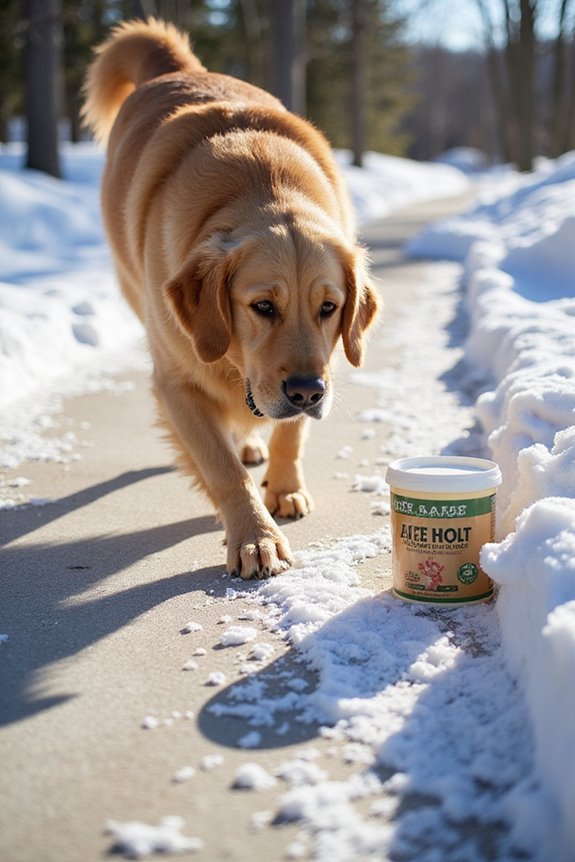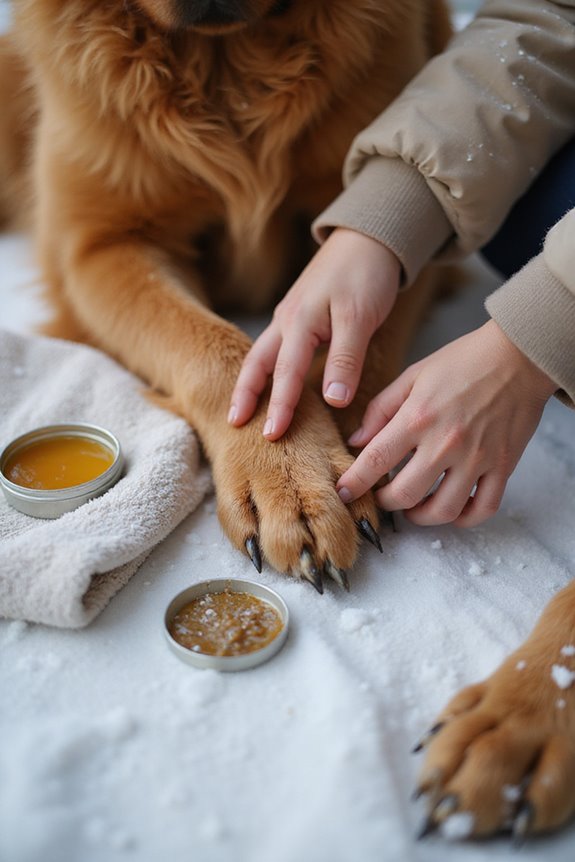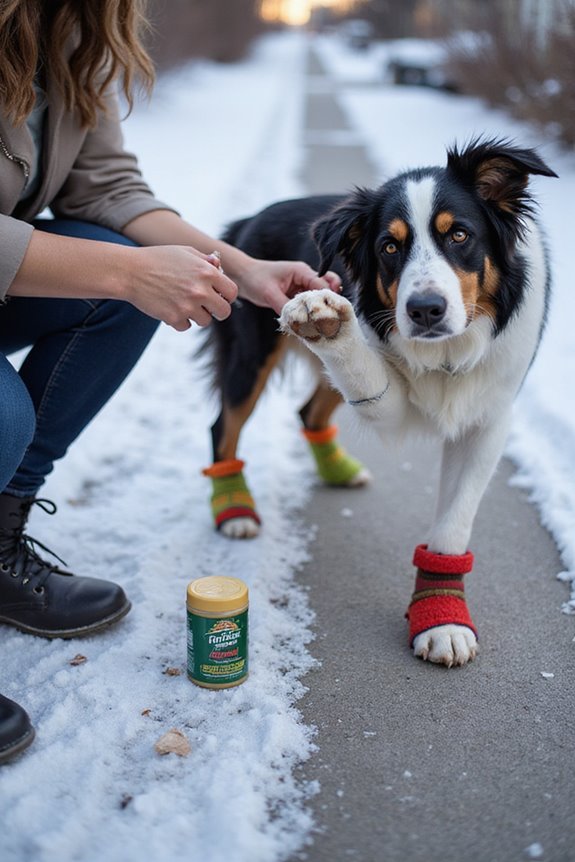To protect your dog from ice and salt, I recommend applying paw wax or balm before walks to retain moisture and using properly fitting booties for added protection. Rinse and dry your dog’s paws after each outing to remove harmful residue, and inspect their paws regularly for injuries. Consider eco-friendly ice melts that are safer for pets, and maintain regular paw care to prevent issues. Following these guidelines guarantees your dog’s safety during winter activities; further insights await.
Key Takeaways
- Apply paw wax or balm to create a protective barrier on your dog’s paws before outdoor walks in winter.
- Use dog booties to shield your dog’s paws from ice and salt during winter walks.
- Rinse and dry your dog’s paws immediately after walks to remove any harmful salt residue.
- Inspect your dog’s paws regularly for injuries or irritations caused by ice and salt.
- Limit outdoor exposure by opting for shorter walks during especially cold or harsh weather.
Understanding the Risks of Ice and Salt on Dog Paws
When winter arrives, the risks associated with ice and salt on our dogs’ paws become increasingly significant. Understanding these winter hazards is essential for ensuring paw safety. Rock salt can create tiny cuts and abrasions, leaving paw pads vulnerable to irritation and infections. Additionally, the sodium chloride’s dehydrating effects can lead to dry, cracked skin. Prolonged contact with ice melt may result in chemical burns, further compounding the risk.
It’s also important to recognize behavioral factors; dogs frequently lick their paws after walks, which can lead to the ingestion of toxic substances. Signs of damage include redness, limping, or excessive licking. Monitoring your dog closely after outdoor play can help identify these issues early, preventing more severe health problems from developing.
Effective Preventive Measures for Winter Walks

Protecting your dog’s paws during winter walks requires a multifaceted approach, especially considering the risks posed by ice and salt. Here are some effective preventive measures for paw protection and winter safety:
- Paw Wax or Balm: Apply a protective layer before walks to prevent irritation and cracking. This also assists in moisture retention.
- Dog Booties: Invest in properly fitting booties to create a physical barrier, keeping paws safe from ice and salt while also preventing cold exposure.
- Post-Walk Care: Immediately rinse and dry your dog’s paws to eliminate harmful residue. Inspect for injuries regularly.
- Limit Outdoor Exposure: Shorter walks during milder weather can minimize contact with ice and chemicals. Additionally, consider using breathable materials that promote airflow and keep your dog’s paws dry and comfortable during winter activities.
Safe Alternatives to Traditional Ice Melts

As the winter months bring icy conditions, I understand that finding safe alternatives to traditional ice melts is essential for protecting our furry companions. Here are some pet-safe options you might consider:
- Eco-Friendly Ice Melts: Look for products based on propylene glycol or urea, as they are generally safer for pets and the environment. Avoid ethylene glycol, which is highly toxic.
- Homemade Solutions: A mixture of dish soap, diluted rubbing alcohol, and hot water can effectively melt ice while being less harmful.
- Natural Traction Enhancers: Sand and kitty litter are non-toxic alternatives that improve traction without melting ice.
- Commercial Products: Opt for sugar beet-based melts or potassium chloride—both are less harmful but should be verified as truly pet-safe to avoid irritation.
Regular Dog Paw Care and Maintenance

Maintaining your dog’s paw health during winter is essential for their comfort and safety. Regular inspections can help with paw injury prevention; I always check for cuts, cracks, or signs of irritation. It’s also important to look for snow buildup between toes, which can cause discomfort. Here are some winter grooming tips:
- Trim excess fur between the pads to prevent snowballs.
- Keep nails neatly trimmed to avoid painful breaks.
- Examine paw pads for dryness or cracking, worsening in cold weather.
- After outdoor walks, wash and dry paws to remove irritants.
- Apply paw balms or musher’s wax for added protection. Additionally, using lick-safe formulations can provide peace of mind for pet owners concerned about their curious dogs.
Choosing the Right Products for Winter Protection

Winter presents unique challenges for dog owners, especially when it comes to keeping our pets warm and safe. To effectively protect our dogs, we should choose products that utilize high-quality insulation materials. For instance, PrimaLoft Black insulation offers warmth without bulk, making it a great choice. Coats with a fleece lining can enhance comfort and warmth, especially for shorter-coated breeds.
Moreover, selecting items with durable waterproof coatings is vital. Look for materials with at least a 10,000mm water column rating, which guarantees protection against wet conditions. It’s important to avoid non-repellent materials that can lead to chilling. Finally, focus on proper fit and adjustable features, making sure that our dogs can move freely while staying warm and dry during winter adventures. Additionally, consider options like dog coats with built-in harnesses that provide both warmth and convenience for outdoor activities.
Frequently Asked Questions
Can Ice and Salt Affect Dog Health Long Term?
I’ve seen the long-term effects on my dog’s paw health from ice and salt exposure. It’s heartbreaking watching them suffer. That’s why I’m committed to protecting their paws and ensuring they stay happy and healthy.
How Often Should I Check My Dog’s Paws in Winter?
I check my dog’s paws after every winter walk. The paw inspection frequency becomes so important in cold weather. Regular checks guarantee our winter paw care routine keeps her comfortable and healthy, preventing injuries and irritation.
Are Certain Dog Breeds More Susceptible to Salt Damage?
It’s fascinating how some sensitive breeds are more vulnerable to salt damage. I’ve found that using protective measures, like rinsing their paws regularly, can make a big difference in keeping their skin healthy and happy.
What Signs Indicate My Dog Has Paw Injuries From Salt?
I notice injury symptoms like redness or cracking on my dog’s paws, especially after winter walks. Their paw sensitivity shows when they limp, lick excessively, or hesitate to walk; it’s heartbreaking to see.
Can Snowballs Cause More Harm Than Salt on Dog Paws?
I’ve found that snowball hazards can indeed cause more pain than salt on my dog’s paws. Proper paw care, like trimming fur and using booties, keeps my furry friend comfortable and safe during winter walks.




